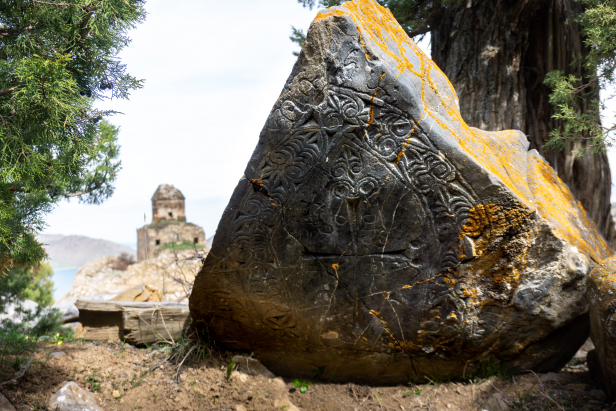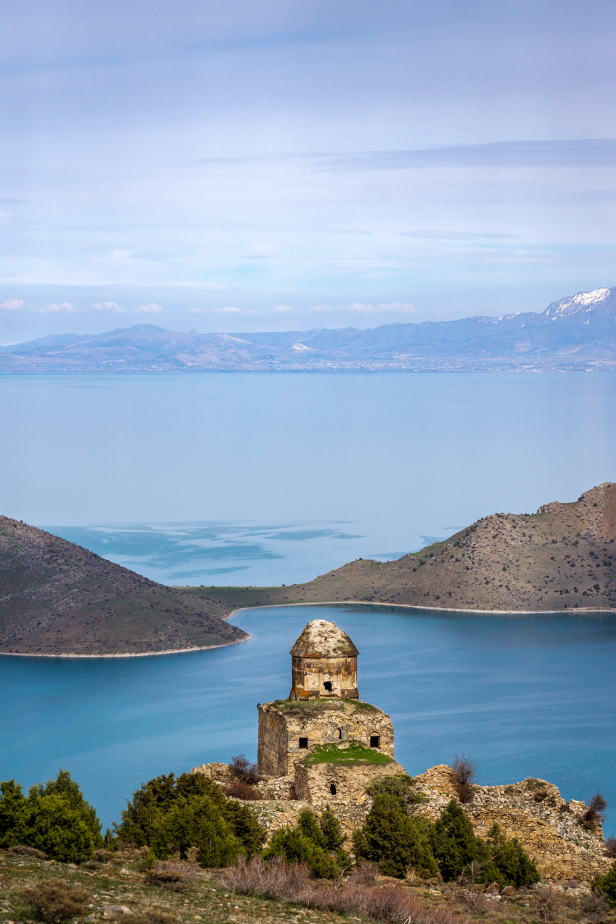Surp Tovmas (St. Thomas) Monastery Kantzag
Surp Tovmas Manastırı, Altınsaç, Van
/ By Josh
Cost: Free
Great for: Armenian History, Armenian Churches, Monasteries, Mountain Views
Perched on a high promontory above the undulating coastline of Lake Van is the medieval Armenian monastery of Surp Tovmas (St. Thomas), one of the stunning historical sights left by Armenian people who once inhabited this beautiful landscape.
While little is known about the history of this monastic complex, it was likely built in the 11th century and expanded over the following centuries up until the 17th century.
Some sources refer to the complex as The Monastery of Surp Tovmas of Kantzag referring to the nearby village now known as Altınsaç where you can see the remains of two other churches (see more about the Armenian Churches at Altınsaç).
Subscribe to The Art of Wayfaring
Surp Tovmas Monastery is believed to have been built to house the relics of St Thomas that were sent from Edessa. St Thomas, who is also known as The Apostle to the East, brought the Christian faith to the lands East of the Roman Empire, most famously all the way into India. His remains were sent to Edessa which had become a major center of Christianity in the East by the early 4th century. In the 6th century Edessa came under Arab control, though in the 11th century it was briefly held by Byzantine as well as Armenian forces. It would have been during this period that relics of St Thomas would then have been brought into the Armenian heartlands and the Monastery of Surp Tovmas built. According to French historian Jean-Michel Theirry, the relics remained at Surp Tovmas until the late 19th century. During this time the church was looted and finally abandoned during what would become known as the Hamidian Massacres.

Surp Tovmas Monastery was built in a period of relative peace and prosperity for the Armenian population and the church was built in a grand style: a high, peaked cupola set atop a rectangular nave. The primary church structure was fronted by a generous triple aisled zhamatun (narthex), with domes in the vaults of the central aisle. The pillars and walls of the zhamatun in particular are covered in crosses, carved into the stone and plaster.
In 1671 a wall was erected to create a courtyard to defend the site against raids. The enclosure wall and inscription remained in fair condition until at least the 1980s after which looter’s pits destabilized the walls and they began to collapse. Today little remains of the outer walls and the lesser buildings that had been built against them.

Directly uphill (west) of the church and monastic complex are the remains of a graveyard. The large Khachkar gravestones have been upended, and the graves dug up and looted repeatedly over the years and into the present. Though not as fine as the Khatchkars of Akdamar, the gravestones here are made in a similar style, using irregular shaped blocks with crosses and patterns carved into the uneven surface of the block.
Despite the fact that the Monastery of Saint Thomas has been gaining more attention from visitors over recent years, the historical site has received no official protection and looters and weather have wrought incredible damage to the site. Holes have been cut into the walls by misguided treasure hunters, and the once-pointed roof of the church has been broken flat. The interior of the church is full of manure as shepherds shelter their animals in the once sacred space.
Surp Tovmas Monastery is often confused with the nearby Altınsaç Village Church. Altınsaç Church, which may have been known as Surp Asdvadzadzin, is actually a pair of historic Armenian churches built in the village of Altınsaç (Historic Kantzag), which are the last remaining churches here as at least two others were destroyed in living memory.
How To Get There
General
One reason for the growing popularity of Surp Tovmas Monastery is the relatively easy access to the site. While most other churches in the area require some research and some hiking, it’s possible to drive within 100 meters of the monastery. While access is relatively easy, Surp Tovmas is still rather remote and the only way to access it is to either have your own car or hire a driver for the day.
To reach The Monastery from the city of Van, head south on the İpek Yolu Highway (Silk Road Highway, D300) roughly following the lakeshore westward. About 53 kilometers after leaving van you will reach an exit for the village of Göründü, follow this to your right, passing through the village of Göründü, and continue along the lake shore for another 16 kilometers. Along this road you will come to the village of Altınsaç (historic Kantzag) where you will see a pair of Armenian Churches now used as barns across from the village spring. Continuing through the village you will pass over a high hill then come down on the opposite side into a broad valley. To your left, high on the slope you will catch your first sight of Surp Tovmas. Follow the dirt track on the left through the valley and up the steep track to the monastery. The road is dirt and its condition subject to change so keep an eye out for deep mud and rocks.
For more about car rental and driving in Turkey make sure to read our full drivers guide.
Where To Stay
Without any hotels in the immediate area, you’ll have to look in the city of Van/Edremit area. Between the Van Airport and Edremit you’ll find some of the city’s top high-end hotels (there are others in the city center as well), whereas most of the standard 3-star types will be found nearer the center of the city itself.
Other Tips
Planning on visiting Surp Tovmas Monastery? See our full list of guides to the Armenian Churches and Monasteries of Lake Van. Make sure to check out the village churches in Altınsaç and Göründü, as well as the Karmrakvank Monastery in the high valleys near the village of Göründü.
Subscribe to The Art of Wayfaring
Have any tips or info to add? Spot any mistakes? We’d love to hear about it.




